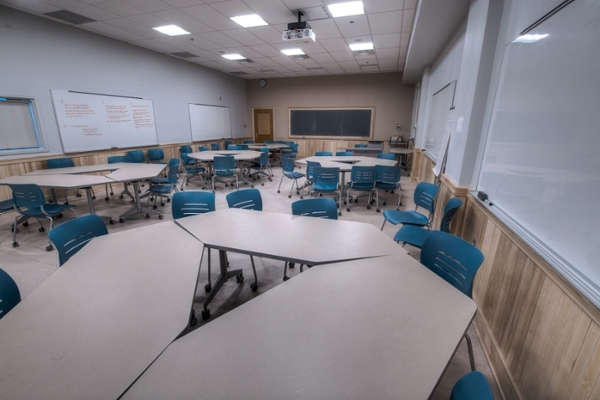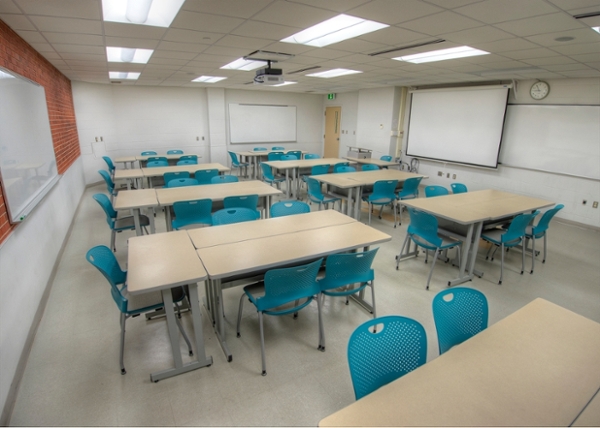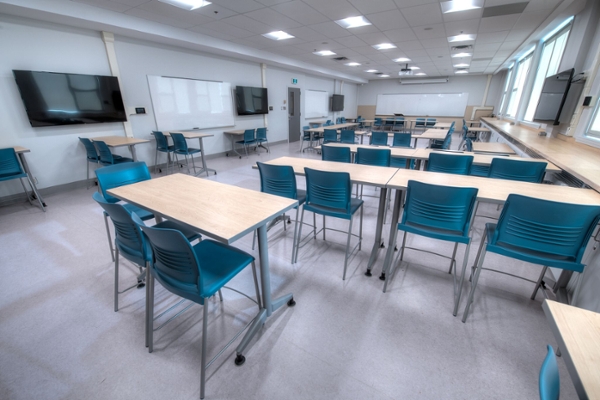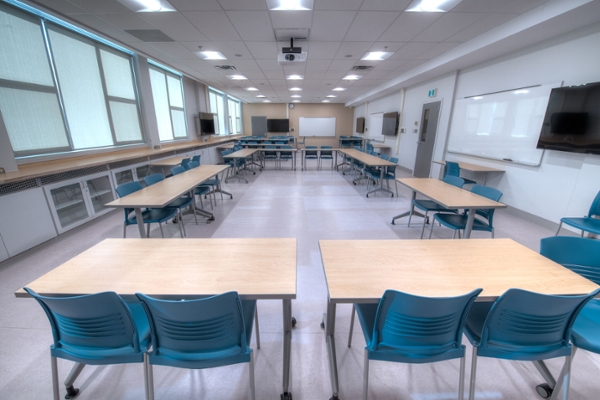Active learning classrooms
Active learning is any approach to instruction in which students are asked to engage with material through writing, talking, listening, problem solving or reflecting.
Researchers have consistently found that higher student achievement and engagement are associated with instructional methods involving active learning techniques and students employing active learning strategies in the planning, monitoring, and evaluation of their learning progress have been found to outperform peers lacking these skills.
Active learning classrooms can be broken into three categories:
- Flexible learning spaces
- Low-tech classrooms
- Tech-enabled classrooms
UNB has a variety of classrooms which support active learning strategies.
Forestry 305

Forestry 305, has large, modular tables that can be rearranged to facilitate group work.
Singer 161

Singer 161 has flexible seating and whiteboards around the room.
Marshall d'Avray 334-1

Marshall d'Avray 334-1 has been designed explicitly for tech-driven active learning. Designed to promote active and collaborative learning, the room features flexible seating that can be easily configured for group work.
There are large whiteboards around the room and five, 65” LED monitors which students can connect to via Air Media or cables. Students working collaboratively at one of the monitors can share their work with a student group at another monitor or share their project with all of the other groups.

Instructors can have their own material projected at the front of the room and, if they wish, can send it to one or all of the student monitors and then take the material being displayed on one of the student monitors and project it at the front of the class for everyone to see, or even send it to another student display. The room was built from the ground up to foster and encourage team-based, cooperative learning.
Challenges
Active Learning Classrooms foster a student-centered learning experience but they can present new challenges for both instructors and students.
Sightlines
Some students will have their backs to the instructor, and you may not know where to stand when you want everyone’s attention, so you should identify a focal point in the room – perhaps the instructor display using the main projector. Other instructors might get into the habit of moving to the centre of the room, between the student pods, when they want to gather the attention of the whole class.
Being able to move around the room is essential for full student engagement, you may want to consider purchasing a remote to advance slides on your laptop from wherever you’re standing.
Noise and distractions
This style of learning will naturally lead to a higher volume of student chatter in your classroom. At first, it may feel like you don’t have control of your class but it’s important to remember that is not necessarily a problem. Noise often indicates student engagement. Establish a cue that lets students know you want their attention and that they should stop talking. Moving between the random noise of group work to the controlled atmosphere of class discussion can be a difficult transition and it’s important that you let the class know you need their help with it.
If you suspect students are being distracted by their devices you may consider asking students to close their laptops to ensure their attention is on you. It’s important that you circulate through the room to monitor student work and ensure they are staying focused on classwork.
Be alert to the possibility that some students may find this style of learning overwhelming. Not everyone is comfortable participating in class discussion. Be sure to watch for any students who might be struggling with the format and consider accommodations.
Resources
Active learning increases student performance in science, engineering, and mathematics
Students performing in the 50th percentile of a class based on traditional lecturing would, under active learning, move to the 68th percentile of that class — meaning that instead of scoring better than 50% of the students in the class, the same individual taught with active learning would score better than 68% of the students being lectured to.
The Canadian Journal for the Scholarship of Teaching & Learning
Monica found that students’ physical approaches to the class material—getting up and writing on whiteboards and moving between groups—was key to students spending time to develop more detailed answers to her questions, engaging in a form of inquiry that Ivan described as “less about absorbing information from a lecture and more about discovering content on their own.”
Higher Education Research & Development
An institutional survey was used to gather more than 35,000 units of student perception data from all 306 courses in the programme. Our empirical findings show that students thought courses that adopted an ACL as the key learning environment were significantly better designed and more encouraging of student creativity and innovation than courses which used regular classrooms; thus, student perceptions were improved. We are also the first to report that this positive effect on creativity and innovation is statistically unaffected by academic performance, with high, middle and low achievers all benefiting from the use of the facility. The results suggest that ACLs are better environments for nurturing innovation for all students, regardless of their academic ability.
